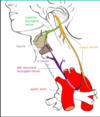Head and Neck Practical 1 Flashcards
Describe course of external jugular vein
Formed just inferior to ear, makes it way across angle of mandible and passes superficially across sternocleidomastoid muscle, passes through posterior triangle of neck and drains into subclavian vein
At what vertebral level do we find the hyoid bone?
C3
At what vertebral level do we find the thyroid cartilage?
C4-C5
At what vertebral level do we find the cricoid cartilage?
C6
At what vertebral level do we find the bifurcation of the common carotid artery?
C3-C4
What is this bone?

Mandible
What is this bone?

Hyoid
What is this?

Thyroid cartilage (esp. laryngeal prominence/Adam’s apple)
What area is being pointed to?

Anterior triangle of neck
What area is being pointed to?

Posterior triangle of neck
What muscle is being pointed to?

Sternocleidomastoid muscle - forming division between anterior and posterior triangle
What is the base/superior border of the anterior triangle?
The inferior border of the mandible

What is the anterior border of the anterior triangle?
Midline of neck

What is the posterior border of the anterior triangle?
Anterior border of sternocleidomastoid muscle

Contents of anterior triangle?
- Suprahyoid muscles
- Infrahyoid muscles
- All of these are in anterior triangle except the inferior belly of omohyoid which is found in the posterior triangle
- Common carotid artery
- Internal jugular vein
- Lobes of thyroid gland (deep to infrahyoid muscles)
What is being pointed to?

Inferior belly of omohyoid
What vessel is being pointed to?

Common carotid artery
What vessel is being pointed to?

Internal jugular vein (deep to SCM)
What is being pointed to?

SCM
What forms base of posterior triangle?
Clavicle

What forms anterior boundary of posterior triangle?
Posterior aspect of SCM

What forms posterior boundary of posterior triangle?
Anterior border of trapezius muscle

Contents of posterior triangle?
- Inferior belly of omohyoid
- Trunks of brachial plexus
- Accessory nerve (CN XI)
- Apex of lung
- External jugular vein
What is being pointed to?

A trunk of brachial plexus
What nerve is this?

- accessory nerve (CN XI)
- Pierces SCM as well as the trapezius (innervating both)
What does accessory nerve (CN XI) innervate?
Sternocleidomastoid and trapezius
Part 1:
- Stab wound to right side of neck
- Presents with pain and paresthesia down lateral aspect of right arm
- Difficulty abducting arm
- 4cm wound in right posterior triangle in neck
What structures would you be worried about?
Part 2:
- Plain chest radiograph excluded a pneumothorax
- No elevation of right hemidiaphragm to suggest phrenic nerve injury
- No evidence of spinal cord injury
- Neurological examination of lower limbs was normal
- Peripheral pulses normal in limb and no significant haematoma in neck
- Examination of upper limb revealed light touch sensation was reduced in C5 and C6 dermatomes
- Unable to initiate abduction of shoulder
- Only able to abduct arm when gravity was eliminated
Part 1:
- Contents of posterior triangle e.g:
- Apex of lung
- Trunks of brachial plexus
- Accessory nerve
Part 2:
- Can rule out injury to apex of lung (as no pneumothorax)
- Can rule out injury to spinal cord
- Can rule out injury to blood vessels
- Sensory findings + inability to initiate abduction of shoulder –> implies injury to nerve supplying supraspinatus
- Abduction of arm usually controlled by C5 myotome
- C5 and C6 spinal roots combine to form superior trunk of brachial plexus (found in posterior triangle of neck)
- C5 and C6 fibres combine to form suprascapular nerve which innervates supraspinatus which is responsible for initiating abduction
- Some fibres also contribute to axillary nerve (again reudcing ability to abduct)
What is the ansa cervicalis? What does it innervate?
A loop of nerves that are part of the cervical plexus, formed from contributions from C1, C2 and C3 spinal nerve roots. Innervates:
- sternohyoid
- sternothyroid
- omohyoid muscles (superior and inferior belly)
The only infrahyoid muscle it does not innervate is the thyrohyoid muscle.
What innervates thyrohyoid?
C1 nerve through a branch of the hypoglossal nerve
Where are the infrahyoid muscles located?
Inferior to the hyoid bone
What can the infrahyoid muscles be split into?
2 superficial muscles and 2 deep muscles
What muscle is this?

Omohyoid (has 2 bellies - superior and inferior)
Attachments of inferior belly of omohyoid?
- Arises from scapula
- It is attached to the superior belly by an intermediate tendon, which is anchored to the clavicle by the deep cervical fascia.

Attachments of superior belly of omohyoid?
- the superior belly ascends to attach to the hyoid bone.

What are the superficial infrahyoid muscles?
Omohyoid and sternohyoid
Attachments of sternohyoid?
- Originates from the sternum and sternoclavicular joint.
- It ascends to insert onto the hyoid bone.

What muscle is this (sternohyoid has been reflected)? What are its attachments?

Sternothyroid
- Arises from the manubrium of the sternum
- attaches to the thyroid cartilage.
What muscle is this? What are its attachments?

Thyrohyoid
- Arises from the thyroid cartilage of the larynx
- ascends to attach to the hyoid bone
What are the deeper infrahyoid muscles?
- Thyrohyoid
- Sternothyroid
What are the innervations of the 4 infrahyoid muscles?
- Omohyoid, sternohyoid and sternothyroid –> Anterior rami of C1-C3, carried by a branch of the ansa cervicalis.
- Thyrohyoid –> Anterior ramus of C1, carried within the hypoglossal nerve.
As a group, what is the action of the infrahyoids?
Contract and depress the hyoid bone (bring it down)
Where are the suprahyoid muscles found?
Above the hyoid bone
Anterior view of suprahyoid muscles

What is this muscle?

Mylohyoid - fibres run horizontally




































